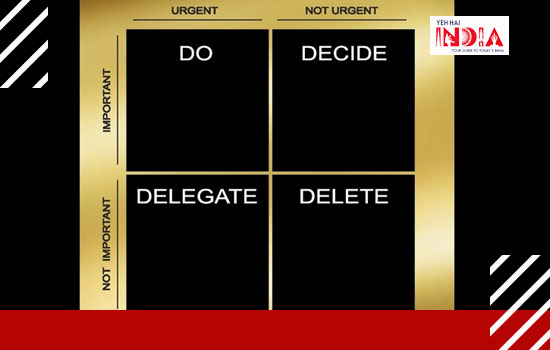Prioritizing work schedule is no piece of cake.
Especially when you have to manage work and life balance, allotting your preferences seem puzzled.
With the new work from home normal, many face troubles like morning sickness, lack of focus, and fatigue.
Here are some effective approaches to tackle your time-management issues.
These approaches are scientifically experimented with and help you pursue daily, short-term and long-term goals.
So, if you find yourself running around putting fires all day, these are some really helpful techniques you should explore:
Recommended Story – How to Increase Productivity while Working From Home?
Eisenhower Matrix

“I have two kinds of problems, the urgent and the important. The urgent are not important, and the important are never urgent.” The statement comes from former United States President, Dwight. D. Eisenhower.
Over three decades after the statement was quoted, Stephen Covey has developed insights for effective time management through his book – The 7 Habits of Highly Effective People.
This famous yet simple and effective tool helps you prioritize your tasks based on their importance and urgency.
This helps you combat the “mere urgency” effect and eliminate time wasters in life.
The matrix helps you divide your tasks into four quadrants.
Those that are Important and Urgent, Important but not Urgent, Not Important but Urgent and those that are neither important nor urgent.
The tool helps you strategize your work based on the nature of your tasks.
Quadrant 1: Tasks that are important and urgent are your list of tasks that you must prioritise over others. These are set of your “to-do lists”.
Quadrant 2: Important but not urgent are the list of tasks that you can schedule for a later date. You can place activities that do not have any particular deadline, but those that are yet needed to be done in this quadrant.
Quadrant 3: Those that are not important but are urgent, are the ones you can delegate.
These are list of tasks that are needed to be done on an urgent basis, but do not essentially require your presence, skills, or knowledge.
Quadrant 4: Neither urgent nor important, are the ones you must try to avoid.
These quadrants make you largely free of pressing distractions and help you to avoid panic.
So, if this tool has helped Mr. Eisenhower become the US president, then definitely it is one you must try!
Pomodoro Technique

A conventional and famous method developed by Francesco Cirillo in late 1980’s, the technique uses a timer to breakdown work into frequent intervals.
This technique has been widely popularized by psychologists, apps, and websites for focus and work efficiency.
The techniques allow you to break your tasks into 25 minutes in length, separated by 5-minute short breaks.
Each interval is known as a Pomodoro.
By structuring your focus strictly into these intervals, you will be able to efficiently work for 50 minutes of each hour!
The technique is based on iterative and incremental development used in software design and pair programming.
The technique has been widely proven to be one of the most effective tools for students and competitive exam aspirants.
Six steps to the original technique:
- Decide the task to be done.
- Set a Pomodoro timer (preferably 25 minutes for beginners)
- Work on your task
- At the end of 25 minutes, take a 5-minute break and put a checkmark on a piece of paper.
- If you have fewer than 4 checkmarks, take a short break (5 mins) and return to step 2. If not, continue to step 6.
- After 4 Pomodoro, take a long break of 15-20 minutes. Then get back to step 1.
This aids your work assimilation and creates focus and flow.
If you find hard to structure your time, then this is something you must definitely try!
Getting Things Done (GTD)

The GTD method is developed by Mr. David Allen through his book under the same name.
GTD is one of the most effective personal productivity systems in the history of time management.
From corporate to computerized systems, the method is adopted to organize workflow in multitude of cases.
The author states that if a task is in your mind, it will fill your mind totally, that is why you find incapable of handling yet another task; therefore, you will fail to complete any of those.
The GTD method rests on the idea of noting all items of your interest, tasks, and projects ‘externally’ out of your mind.
This helps you breaking them into actionable work items with known time limits that bring attention on task of external record than recalling them intuitively.
The GTD allows you to minimize your stress and anxiety when you find yourself with hundreds of things that demand attention.
Recommended Story – Top Ideas to Follow For Increasing Productivity While in Lockdown
Five clear steps of action in GTD:
- Capture: Collect what your attention
- Clarify: Process what it means
- Organize: Put where it belongs
- Reflect: Review frequently
- Engage: Make your decisions and get things done.
Find resources and tools to take GTD to next level here.
Pareto Analysis

Developed by the great Italian economist, Vilfredo Pareto, the Pareto Analysis is a statistical method to organize time.
Also called as the 80-20 rule, the principle states that 80% of the tasks can be completed in 20% of time while remaining 20% of tasks will take up to 80% of your time.
In other words, 20% of your work will constitute about 80% of your achievements.
This helps you yield higher productivity over time.
This principle helps you to analyze where your time is currently spent which helps you further determine where it could be directed.
The method also helps users to search for simpler and easier methods that are less time consuming to complete tasks.
So, if you want to focus on the vital few factors, this technique is something you must definitely try out!
Also Read – Time Management Apps and Tools











